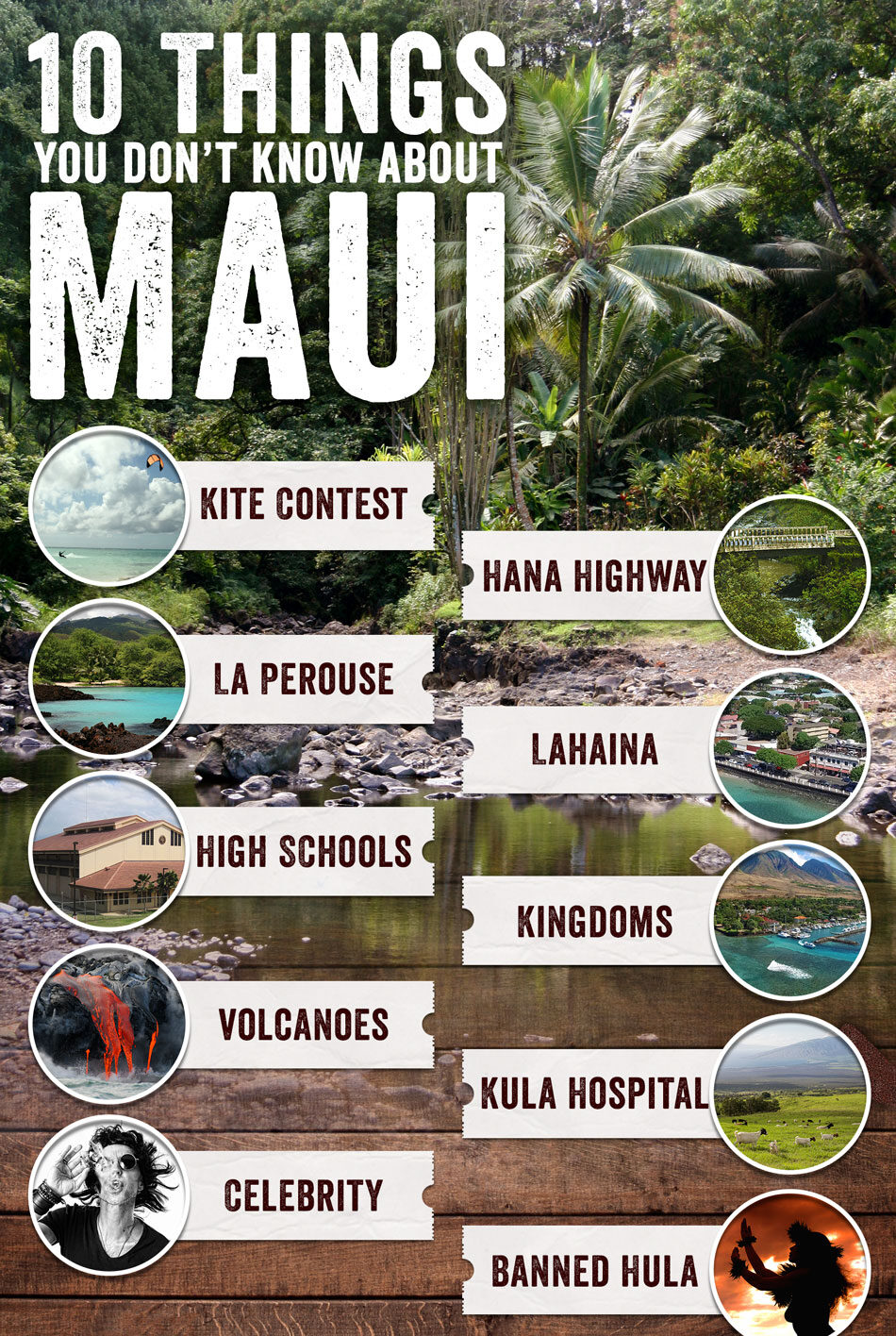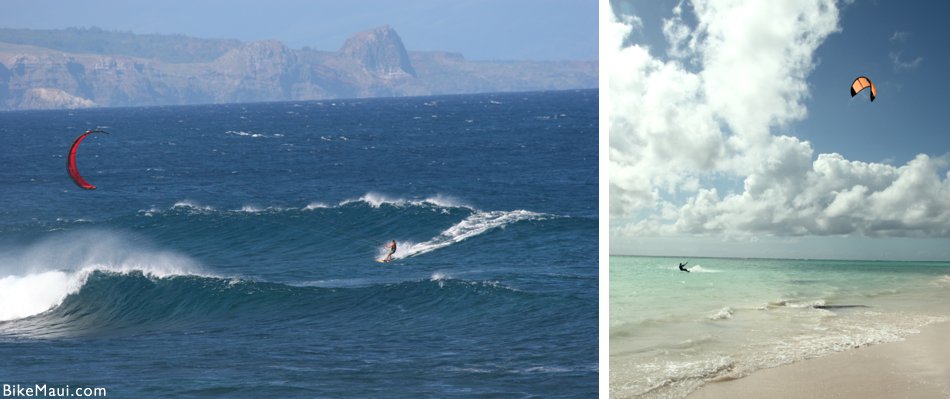Stunning beaches, lush rainforests, some of the choicest surf spots in the world—what most know about Maui reminds us why its consistently ranked the #1 island on Earth.
Most are also aware of Maui’s biggest claims to fame: it’s home to the world’s largest dormant volcano and serves as a sanctuary for the migratory Humpback Whale.
But beyond its obvious merits, Maui also possesses a number of fascinating facets few have even heard of.

Score some pub trivia points—and appreciate your dream destination all the more—with these 10 things about Maui.
1. The world’s first kiteboarding competition was held on Maui.
From the glossy waves off Mexico’s coast to the outside barrels on Oahu’s shores, kiteboarding has become one of the most celebrated ocean sports in the world.
Given its ubiquity, one might be prone to think that this exhilarating watersport has been around for centuries. While different forms of it have persisted since the early 80s, it made its first lasting mark on the world in 1998 when the first kiteboarding competition was held on Maui. Between the island’s glassy waters and the north shore’s ideal wind conditions, the Valley Isle proved to be the perfect place to skim swells and fly in the sky.
Since then, kiteboarding has taken off in more ways than one. Maui has retained its title as one of the leading kiteboarding spots on the planet, and in 2016, the sport was introduced to the Rio Olympics.
2. Hana Highway was built by convicts.
Hop on Hana Highway today—a road that traverses 52 miles, more than 600 switchback curves, and 56 bridges—and you’re bound to feel the pulse of ancient Hawaii.
The glorious highway—arguably one of the most beautiful in the world—began as a public works project under the reign of King Pi’ilani in the 15th century, who was determined to unite the segregated island through a path that would encircle all of Maui. Upon his death, his son pledged to complete his legacy by finalizing the rugged footpath we know today as King’s Trail.
During the sugarcane boom in the 18th century, that footpath took a turn towards modernization: plantations across the island were in dire need of Hana’s precipitation and construction began to haul its water to the dryer parts of the island with more efficiency.
Such a daunting task—effectively carving a highway through the cliffs—was pawned off to convicted felons at Ke’anae Prison Camp, a now-defunct jail on the Ke’anae Peninsula at the halfway point to Hana.

Restitution, indeed: the endeavor necessitated blasting through rocks with dynamite and lowering in on ropes over cliff faces that dropped hundreds of feet into the sea. Their labor paid off: the highway was completed in 1926 and now caters to more than a million drivers per year.
3. La Perouse Bay is the result of Haleakala’s last eruption.
Head south past Maui’s acclaimed Makena Beach and you’ll come face to face with the youngest part of the island at La Perouse Bay.
The unsullied lava fields, red-tinged cinder cones, and fertile tide pools are the result of Haleakala’s last eruption—a monumental event in 1790 that expanded the island and paved the way for the gorgeousness of the south side we know today.

Its relative newness, in geological terms, has spurred scientists to deem Haleakala a dormant but active volcano. In other words, Maui could conceivably expand more should its shield volcano erupt again. Not a bad thing, considering that the region is considered one of the fastest-growing places in the state.
4. Lahaina was once the capital of the Kingdom of Hawaii.
Lahaina was once a legendary whaling port and the capital of the Kingdom of Hawaii.

King Kamehameha greatly preferred the charming coastal spot and had a palace built in the center of town, naming it Hawaii’s capital during his reign. That title remained for the next fifty years until it was transferred to Honolulu, where today the international metropolis continues to serve as the state’s center of government. Now, we wait as slow progress is done to rebuild Lahaina, homes first.
5. Two of Maui’s public high schools have national claims to fame.
Established in 1938, Wailuku’s Henry Perrine Baldwin High School is on the National Register of Historic Places, perhaps in part because of its legendary father: the high school, which now hosts over 1,600 students, was named after the co-founder of Alexander & Baldwin—a sugar and agricultural giant that continues to privately own a large chunk of prime Hawaiian real estate.

Over on the west side, Lahaina’s Lahainaluna High School goes down in the history books as the oldest high school in the nation west of the Rockies. Founded in 1831, this public school was once a Protestant seminary comprised of thatched huts and missionary teachers; today, it’s known as the alma mater of Keali’i Reichel, arguably one of the finest and most well-known musicians in Hawaii.
6. Maui was once divided into separate kingdoms.
Prior to the reign of King Pi’ilani, the same aliʻi responsible for the ultimate creation of Hana Highway, Maui was divided into three distinct regions—Wailuku, Lahaina, and Hana—with each ruled by a different chief.
As the 15th Moʻi of Maui, Pi’ilani’s supremacy was marked by tremendous advancements in the island’s history, including the start of King’s Trail, the building of prominent heiau (or temples), and the island-wide promotion of industry.

Most notably, however, he united the disparate parts of the island—a ruling that persisted until King Kamehameha’s invasion and conquest. Today, Pi’ilani continues to be venerated: he’s the name behind one of Maui’s most prominent highways.
7. It was also divided by two separate volcanos.
Mount Haleakala might get all the love, and understandably so—with its height and majesty, it looms above the island like a god of its own accord.
But the West Maui Mountains were equally critical to the Maui we now know. This lush, valley-rich range—now substantially eroded—erupted before Haleakala, in effect giving birth to the island of Maui. Given the proximity of the volcanoes, their lava flows overlapped, fusing the two in the isthmus we recognize today as Central Maui.

And ever wonder why Kahoolawe, Molokai, and Lanai are part of Maui County? Know this: roughly 20,000 years ago, the four islands were connected, comprising what geologists now refer to as “Big Maui” (or “Maui Nui”). A fleeting ice age caused the sea to rise, thereby separating the islands by water—and explaining why the channels between the islands today are considerably shallow.
8. Kula Hospital once served as a sanitarium for tuberculosis patients.
This upcountry medical center in Keokea may seem small in comparison to Wailuku’s Maui Memorial, but it holds a vital place in the island’s healthcare history.
Founded in 1910 by Dr. W.F. McConkey, the hospital was established to address the tuberculosis epidemic, which was once the leading cause of death from an infectious disease.

Kula Sanitarium—or “Kula San”—has faced several transitions since its inception; now an acute and long-term care facility, it’s received one of the top ratings for its services.
9. Maui is home to a Poet Laureate, the daughter of a Pulitzer Prize winner, a Grand Ole Opry alum, a multi-Grammy award winner, and an Oscar nominee.
Maui may be famous for its spectacular beaches, but it’s also home to some of the preeminent actors, musicians, writers, and personalities on the planet.

To note: W.S. Merwin—the former Poet Laureate and the founder of the W.S. Merwin Conservancy—lives on Maui’s north shore, sharing the vistas of sugarcane fields and windswept bays with country icon, Willie Nelson. Kris Kristofferson lives in Hana; Mick Fleetwood, of Fleetwood Mac fame, calls the West side one of his homes (and owns Fleetwood’s on Lahaina’s Front Street), and Alice Walker’s daughter Rebecca is an upcountry local. The Queen of Daytime TV—yes, Oprah—owns several acres on Haleakala’s slopes (where she also has an organic farm) while Owen Wilson is often found kicking it in Paia. Call the south side a little more rock and roll: Aerosmith’s Steven Tyler has a home in Makena and is rumored to be one of the coolest gents to cruise Kihei. Wherever you go, you’ll likely run into a low-key celebrity in Maui.
10. Maui’s Queen Ka’ahumanu outlawed hula.
Hula—Hawaii’s ancient form of storytelling—was maligned in the 1800s when Protestant missionaries deemed the dance “lewd” and suggestive. Following their cues, Queen Ka’ahumanu—a Maui girl who was born in Hana and converted to Christianity—officially banned hula from public performances in 1825.

Hula remained largely clandestine for decades to come, and when the ban lifted in 1851, public hula demonstrations could only be performed if accompanied by a hefty fee. Thank King David Kalakaua for the resurgence of this lost art: his inauguration, celebrated with hula performances, was followed by the assertion that “Hula is the language of the heart and therefore the heartbeat of the Hawaiian people.” To which we say, Hana Hou—and mahalo nui.














6 comments
Not a word about having the most spectacular sunsets and rainbows so I assume you think everybody knows that. Everyone who has experienced Maui does know but what about the ones not visited there!
Another person of note, Woody Harelson, has lived on Maui for almost 20 years.
Lots of interesting facts, but many inaccuracies and omissions. W S Merwin died on March 15, 2019. You forgot Woody Harrelson, Don Nelson, Jim Carrey, who also live here. Please use Mauna Kahalewai to refer to the mother of Maui. Camp Keanae, which housed the prisoners, is now a YM/YWCA camp.
Spectacular sunsets and rainbows? Yes, absolutely. But on my many trips to Maui, one thing especially stands out in my mind… the smiles and the calm on the faces of almost everyone I see there. No, not just on The faces of the giant hotels or gift shops where it’s expected, but even present on workers doing seemingly menial tasks. Digging in flowerbeds, sweeping, and the like, when no one is watching them that they are aware of. What greater testimonial to contentment is there?
The Hawaiian Islands make up just .2% of U.S. land, but 25% of the nation’s most endangered species are in Hawaii. The islands are often referred to as “The Extinction Capital of the World” because the species are dying out at an alarming rate. Five endangered species live on Maui: Hawaiian Goose (Nene), Hawaiian Green Sea Turtle (Honu), Hawaiian Hoary Bat (‘ope’ape’a), Hawaiian Monk Seal (‘Ilio’holo’I’ka uaua), Humpback Whale (kohola), Scarlet Honeycreeper (‘I’iwi). Visitors can do 5 things to help Maui: Use reef friendly sunblock, not sunscreen; Straws-decline when offered, they stay in the environment for 100 years; Water bottles-go to grocery store and get the large, refillable jugs of water, use it to refill your own water bottles; Recycle your cans and bottles, separate them from your trash; Pick up trash- Maui is very clean because everyone picks up trash-you can help by picking up any trash you see.
Love Maui, golf, Im a New Zealand Maori carver and have been asked if I could live there. I would since there is so much for me to do. Some of my choices for photography are, Hana, palms water enjoyments friendship. The slopes of MT. Haleakala photography is some of the best. Lahaina I love and have a photo that I think is a world photo. They are some of my favorite places for photography. My son and I
Love golf on the east side, sk8 boarding walking, the Mexican food, Island food are all under rated but so scrumptious. If you allow I would love to leave you a few of my photos that will stun, if I can?